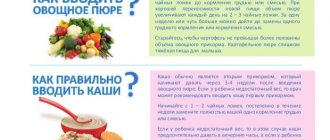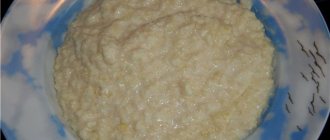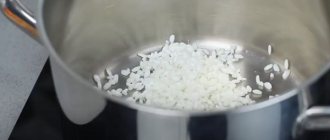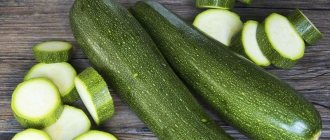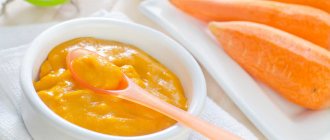Introduction
Complementary feeding – all food products (except formula and breast milk). For young children, these are cereals, purees, juices, fruit drinks, teas, etc.
The purpose of introducing complementary foods is not only to satiate the child, but also to ensure that his body receives nutrients in an age-appropriate quantity and quality. A child of the first year grows and develops very intensively. Nutrition should provide the body with resources through which this development occurs. Porridge, i.e. Grain complementary foods are necessary for the baby as a source of carbohydrates, vegetable proteins, fats, vitamins and minerals.
The composition of porridges can be improved by adding prebiotics, omega fatty acids, various additional functional ingredients and, of course, adapted milk formulas. We are, of course, talking about industrially produced cereals, the benefits of which over homemade cereals are now beyond doubt.
When to introduce porridge?
- The European Society of Pediatrics, Gastroenterology, Hepatology and Nutrition (ESPGHAN) clearly recommends the introduction of complementary feeding between 17 and 26 weeks.
- The minimum age for introducing complementary foods is 4 months. Until this time, the baby is simply not ready to digest and assimilate food other than breast milk. His body is simply not yet mature for this.
- In accordance with the ESPGHAN recommendations, the Russian Union of Pediatricians also recommends introducing complementary foods between 4-6 months. It is this age that doctors call the “critical window” for the formation of adequate food tolerance (tolerance) and the prevention of nutritional deficiencies in the body.
- The timing of the introduction of complementary foods is set by the doctor individually for each child. The pediatrician takes into account the level and characteristics of the development of the digestive and central nervous systems.
- It is preferable for a healthy child to introduce complementary foods at 4-5 months.
- An underweight child with frequent bowel movements is usually given porridge first, while overweight children are given puree.
Which cereal is better?
Pediatricians say that buckwheat porridge is the most suitable, indeed, the only correct choice for mothers to introduce the first complementary foods at the age of 6 months.
Buckwheat is a unique grain containing a huge amount of beneficial nutrients. It also contains organic acids - linoleic, citric, oxalic, etc.; vitamin complex – vitamins B, C, E, PP; as a source of energy - carbohydrates and even calcium, necessary for the proper development of the musculoskeletal system; magnesium, potassium - for normal functioning of the heart muscle; selenium and zinc – for the proper functioning of the nervous system.
This composition has a beneficial effect on the immune system of a baby in the first year of life and activates T cells in the fight against infections and other diseases. Solid dietary fiber contained in buckwheat porridge helps digest food, enhance intestinal motility and improve metabolism. That is why buckwheat will not cause problems in the baby’s gastrointestinal tract.
The absence of gluten in this cereal is also the most important aspect when choosing porridge for the first feeding. Unlike everyone’s favorite semolina or oatmeal, buckwheat is devoid of this complex protein, which has long been recognized by the Russian pediatric community as harmful to the growth and development of infants. And the iron content in buckwheat porridge is five times higher than in rice and semolina.
How to understand that a child is ready for complementary feeding?
- The child is 4-6 months old.
- The child’s “spoon pushing reflex” disappears and he can already swallow thicker and semi-liquid food. The child can drink from a spoon without spilling the contents on the chin.
- If the child eats more than a liter of formula per day and is not satisfied.
- If during breastfeeding the child ate from both breasts and remained hungry.
- The baby is purposefully trying to put something in his mouth.
- The child is interested in food and is drawn to it.
Which porridge should I choose?
When introducing grain complementary foods, it is recommended to adhere to certain principles for choosing porridge.
- Mono-component porridge (from one grain, without adding fruit).
- Gluten-free (does not contain gluten/gluten, which is a strong allergen).
- Dairy-free porridge, because... Pure animal milk is not recommended for children under one and a half to two years of age. Gluten is found in all cereals except buckwheat, rice and corn. But corn is recommended for inclusion in a child’s menu no earlier than the fifth month.
- It is preferable to choose porridge with an adapted milk formula, which is very nutritious and provides a smoother transition to food with a new texture.
- The best weaning cereals should not contain crystalline sugar (a potential allergen) and should be sweet and tasty due to the raw materials used, and not added sugar, fructose or maltodextrin.
Choosing porridge to start complementary feeding
Mom should know that with all the variety of cereals and methods of preparing cereals, only certain options are suitable for the first complementary feeding:
- Gluten-free (buckwheat, rice, corn). Gluten is a plant protein found in certain types of cereals (oats, wheat, barley). It is quite difficult for a child’s body to absorb it at first (stomach pain and bloating are very likely), but as the digestive system matures, this problem disappears (special enzymes are produced to break down gluten).
The first complementary foods should be only gluten-free cereals - it will be easier for children’s gastrointestinal tract to digest them
- Dairy-free (cooked in water; you can also dilute dry cereals with breast milk or formula). This product contains no lactose. This is a carbohydrate that can cause allergies and digestive upset in a child (especially if the porridge is immediately prepared with whole cow's milk). Of course, milk porridges have a more pleasant taste, but the children's gastrointestinal tract must again be ripe for such food.
The first porridges should be dairy-free; for a child’s gastrointestinal tract this is too heavy food, which he will master only with time.
- Mono-component. The first porridges should consist of one type of cereal (this will allow you to determine the source of a possible allergy or stomach upset). After successfully introducing several options into the diet, they can already be combined.
- Without additives. For the first feeding, porridge in its “pure” form is suitable - without pieces of fruit, nuts, vanillin, honey, etc. Many of these products have high allergenic properties, and they should be included in the dish very carefully when the child is completely comfortable with a certain type of porridge. Naturally, flavorings, thickeners, and other chemical additives are not allowed in baby cereals.
- Instant (no cooking required). Most pediatricians recommend starting the first complementary foods with industrial cereals. They are produced using strict technologies that facilitate digestion and are additionally enriched with useful ingredients. This dish is prepared instantly: just take the dry mixture and combine it with water at a certain temperature (of course, everything is taken in the right volumes to get the ideal consistency for the baby).
Optimal cereals for the first grain feeding
4+
months
Kabrita Rice porridge with goat milk
180 g
Dry instant rice porridge with Kabrita adapted milk formula
4+
months
Kabrita Buckwheat porridge with goat milk
180 g
Dry instant buckwheat porridge with Kabrita adapted milk formula
Both Kabrita® porridges are mono-component, prepared with an adapted mixture based on goat’s milk, which provides a double advantage for the child’s fragile digestive system. Adapted milk formula makes the transition to cereals as gentle as possible and continues the effect of breastfeeding, and goat's milk as the basis of formulas is perfectly digestible and well tolerated by young children.
Kabrita® porridges are additionally enriched with prebiotics and a unique DigestX® fat complex, which improves digestion, increases energy metabolism and improves calcium absorption.
Kabrita® porridge is prepared from rice flour, buckwheat and other grains. To obtain a more delicate and gentle consistency, part of the grain is subjected to gentle splitting technology, which allows the child to digest the porridge faster and easier, and also adds sweetness to the dish without adding sugar.
How to prepare porridge for the first feeding?
Making porridge for your baby yourself is quite simple, just follow these simple recommendations:
- The grain granules must be very fine, so use a blender or coffee grinder.
- Food for small children is made only with filtered water, such water can be bought in a supermarket, it is sold in the children's department or near ordinary water with the inscription “for children”.
- Add cereal at the rate of 5–10 grams per 100 mg of water
- Add a little breast milk, so the baby will be more willing to eat
- You cannot add any third-party additives, even salt and sugar, only cereals, water and breast milk as needed
How to cook buckwheat porridge?
- For cooking as a pan, we will use a double boiler.
- First, prepare 1 spoon of cereal and 50 ml of water for children
- Then, put 1 liter of water into the steamer
- Place the pre-soaked cereal in a saucepan and fill with water
- Leave to cook for 40–50 minutes with the “vitamin preservation” function set.
- Throw the finished cereal into a blender and mix it thoroughly, and at the end add a little boiling water or breast milk
- The result is a very tender paste that your baby will definitely like.
Preparing rice porridge for the first feeding
- The rice needs to be washed well and sorted so that it is clean.
- Pour 1 liter of water into the steamer
- Take one spoon of cereal and 100 ml of liquid
- To prepare, take a glass pan from a double boiler
- Set the timer for 50 minutes while preserving vitamins
- After boiling, rice porridge needs to be simmered until fine along with water, it is in it that the beneficial vitamins remain after boiling
The child will be happy to eat porridge prepared in this way; do not forget to gradually increase the concentration and portion. See how your body reacts to new foods and, if possible, consult your pediatrician.
How to administer porridge?
- Be patient, sometimes it takes a child 10-15 tries before he gets used to a new food.
- The introduction of porridge and any new complementary foods begins with 1 teaspoon. Dilute the very first porridge thinner so that the child can drink it. Gradually bring the dilution to normal.
- It is better to introduce porridge or new complementary foods in the morning. In the morning, the child’s gastrointestinal tract is actively working. And you will be able to track your child’s reaction to the product throughout.
- First give a teaspoon of porridge, and then supplement with formula or breast milk. It is better to give porridge from a spoon. Over the course of a week, gradually replace one formula feeding with porridge feeding. You can give the first cereals from a bottle, and then move on to feeding from a plate.
- Introduce a new porridge no earlier than 3 months after introducing the first porridge.
- Do not introduce complementary foods if the child is sick, has just been vaccinated, in the heat, or during teething.
- Approximate single servings of porridge for children of different ages: 4-5 months – 150 g 6-7 months – 150-170 g 8 months – 180 g 9-12 months – 200 g
- Give preference to industrially produced cereals. It is not only convenient, but also as safe as possible. All baby food undergoes strict control to ensure the absence of substances harmful to the human body. In addition, all baby food is enriched with vitamins and minerals necessary for the growth and development of the child.
- It is better to cook dairy-free porridges using a mixture; regular milk for making porridges is recommended to be diluted with water in a 1:1 ratio.
- Monitor the temperature of the porridge, do not leave leftover porridge for the next feeding.
- Mix the porridge strictly according to the instructions on the product packaging.
Compliance with norms, first complementary feeding, introduction of porridge
Feed your baby with a small spoon, adding a little at a time to prevent him from choking. Dilute the porridge from 1 to 20 times with water to obtain a liquid that can be easily swallowed by a child.
Important: not all children eat porridge and may refuse, if this happens, then try giving vegetable puree.
Stir the liquid diligently to avoid lumps, start with one small spoon, and then gradually increase the portion. Every day, try to give one small spoon more, so that at 8 months the portion is 150 grams, and per year 200 grams. Don’t forget - every child is individual and if you can’t increase the amount of food so quickly, then contact your pediatrician.
The doctor will check the baby and advise further steps. If you start feeding your child buckwheat porridge, and he accepts it perfectly, then do not change the product for several weeks. Increase the ratio of porridge and liquid, if before it was 1 to 20, now it is 2 to 20. Cereal 10 grams per 100 mg of water.

